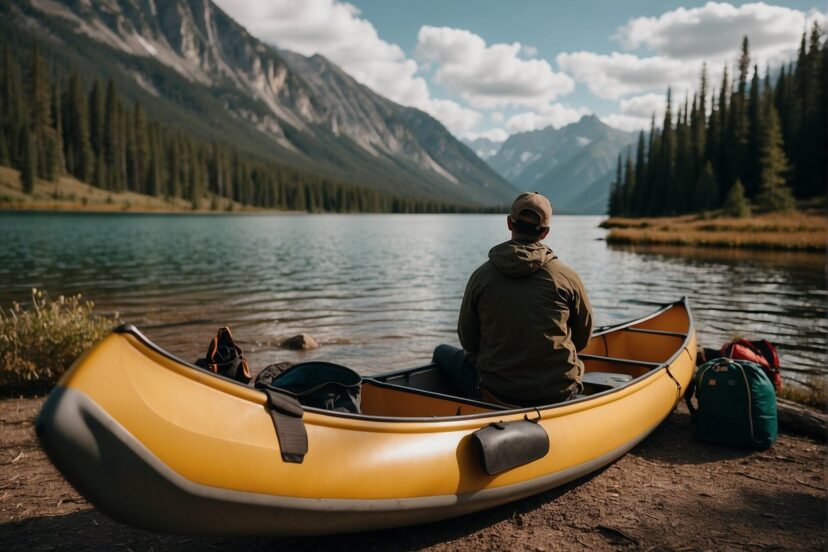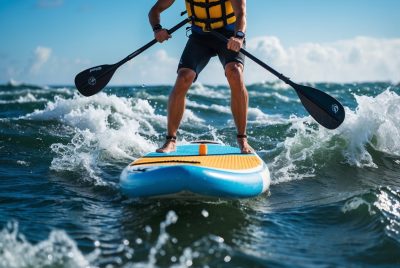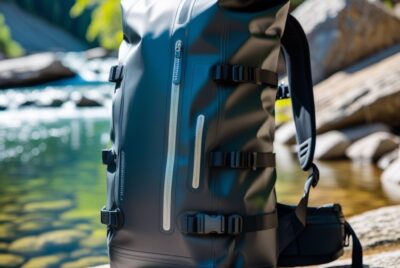Kevlar Canoe Durability: Unleashing the Adventure Potential
*We may earn a commission for purchases made using our links. Please see our disclosure to learn more.
Kevlar Canoe Durability: Unleashing the Adventure Potential
As a durable and lightweight material, a Kevlar Canoe has become a popular choice. Having personally handled various types of canoes, I can attest to the marked advantages that Kevlar canoes offer over their traditional counterparts made from materials like aluminum or fiberglass. These canoes are known for their impressive strength-to-weight ratio, making them a favorite amongst paddlers who value ease of transport and maneuverability without sacrificing durability.

The crafting of Kevlar canoes involves layering the Kevlar fabric with a resin, often with a foam core to add stability and buoyancy. This construction not only contributes to the canoe’s lightness but also to its ability to withstand the rigors of paddling across various water conditions. The resilience of these canoes is noticeable when portaging or navigating through challenging environments, where potential impacts might severely damage or impair a less robust vessel.
From my experience, Kevlar canoes provide a pleasing balance of stability and performance. Their hull designs often enhance the paddling experience with smoother tracking and efficient gliding through both calm lakes and more turbulent waters. While the cost of a Kevlar canoe might be higher than other materials, for avid paddlers or those planning extensive trips, the investment often justifies itself with superior handling and longevity.
Design and Materials

In this section, I’ll discuss the specifics of the design and materials used in Kevlar canoes, focusing on their composition, hull shape and dynamics, as well as size and capacity, which are significant for performance and utility.
Kevlar Composition
Kevlar is renowned for its strength and lightness. As an aramid composite, it’s 40% stronger than fiberglass and can create notably lightweight canoes. These advantages stem from Kevlar fibers woven into a cloth-like material, which, coupled with a sealing resin, form laminates that are both robust and featherlight. In canoe construction, two full layers of Kevlar or more are often applied on top of a gelcoat, a practice ensuring the canoe’s durability.
Hull Shape and Dynamics
My analysis reveals that hull shape plays a pivotal role in a canoe’s performance. The symmetrical hull design is common; it provides balance whether paddling solo or with a partner. Dynamics are critical – the hull’s contours must facilitate smooth paddling and stability. Modern Kevlar canoes may also integrate carbon-Kevlar trims for added stiffness without significantly increasing the weight.
Size and Capacity
Finally, when it comes to size and capacity, my findings underscore that longer canoes offer more storage and are typically better for touring, whereas shorter ones are easier to maneuver. A 17-foot Kevlar canoe weighing mere 35 pounds exemplifies the lightweight advantage of these materials. The Kevlar fusion method—a blend of Kevlar with other composites—can further influence size options by altering the weight-to-strength ratio, catering to diverse paddling needs.
Kevlar Canoe Performance

When I talk about canoe performance, I’m referring to how the boat behaves on the water in terms of paddling efficiency, stability, and its maneuverability and speed. The material and design of a canoe like Kevlar directly influence these aspects, making them critical for paddlers to understand before making a choice.
Paddling Efficiency
Paddling efficiency relates to how effectively a canoe converts my paddle strokes into forward motion. A Kevlar canoe is generally more efficient than its heavier counterparts because of its lighter weight, allowing me to use less energy to achieve the same speed. This means I can paddle faster or cover longer distances with less fatigue. The lighter a canoe, the less drag it creates in the water, contributing to its efficiency.
Stability Considerations
Stability in a canoe is about how well it resists capsizing. Initial stability refers to how stable the canoe feels when I first step into it. Kevlar canoes often have good initial stability, which is comforting for beginners or when paddling on calm water. However, stability also depends on the canoe’s shape and width; broader, flatter-bottomed canoes are typically more stable than narrow, rounded ones.
Maneuverability and Speed
A Kevlar canoe’s maneuverability is a measure of how easily I can change its direction. It is often more maneuverable and therefore can navigate through tight spaces more effectively. Speed, on the other hand, is how fast the canoe can travel. Kevlar canoes, being lightweight and rigid, tend to be fast. Their lightness allows a quick acceleration, while the rigid Kevlar material ensures that the boat doesn’t flex, transferring more of my paddle power into forward motion.
Structural Specifications

In this section, I will outline the physical characteristics integral to Kevlar canoes, focusing on dimensions, weight, and carrying capacity.
Dimensions and Weight
My Kevlar canoe displays a carefully balanced design, with a degree of precision in its measurements that contributes to overall performance and stability. Typically, these canoes come in various lengths, with 16 feet being a common size. They are meticulously crafted to maintain a standard width; a popular model may present a gunwale width of 33.5 inches and a maximum width that can reach up to 35 inches, creating a stable platform on the water.
Weight is one of the most significant benefits of a Kevlar canoe. Kevlar’s lightweight properties allow for a fully constructed canoe to weigh in substantially lighter than its plastic counterparts. For instance, a 17-foot Kevlar canoe might weigh approximately 35 pounds, which makes portaging and maneuvering both on and off the water noticeably less straining.
Load Range and Capacity
The industry capacity for Kevlar canoes is variable, yet these vessels are engineered to support a significant range of load without compromising on performance. To provide specific data, a 16-foot canoe may offer an optimum load range that can comfortably accommodate gear and passengers, often between 900 to 1,100 pounds.
Centre depth, an important specification for in-craft comfort and water line performance, is typically around 13.5 inches, while bow and stern heights are designed to offer an effective compromise between wave shedding and wind resistance. This attention to detail ensures that even when loaded near recommended capacities, my Kevlar canoe maintains its exceptional paddling characteristics and does not become bogged down.
Trip Planning and Canoe Selection

When I plan multi-day canoe tripping adventures, selecting the right canoe is central to the trip’s success. A suitable canoe ensures easy portaging and safe, efficient transport throughout the journey. Below, I’ve laid out essential considerations for choosing your vessel and gearing up for the excursion.
Choosing the Right Canoe
Weight and Material:
- Kevlar Canoes: Ideal for multi-day trips due to their lightweight nature, making portages less strenuous.
Durability:
- Kevlar canoes are durable but not as robust as some heavier alternatives. Consider the trade-off between weight and resilience.
Design:
- Look for contoured seats and yokes, which significantly enhance paddling comfort and ease of carrying the canoe.
Size and Shape:
- Touring Canoes: Offer stability and ample storage for longer expeditions, important for multi-day trips.
- Recreational Canoes: More suitable for day trips on calm waters.
Gear and Accessories
Safety and Navigation:
- Personal Flotation Devices (PFDs): Ensure every trip member has a properly fitting PFD.
- Maps and Compass/GPS: For route finding and staying oriented in the wilderness.
Transport and Portaging:
- Portage Pads: Increase comfort when carrying a canoe over long distances.
- Canoe Cart: Consider using a cart for longer portages or when facing challenging terrain.
Comfort and Convenience:
- Dry Bags: Protect gear from getting wet and organize belongings.
- Contour Yoke Pads: For easier shoulder-fitting when portaging.
By keeping these factors in mind during the planning phase, I set myself up for a rewarding and efficient paddling experience. Proper gear and a well-chosen canoe make all the difference in enjoying the serenity of the waterways and the beauty of the natural world.
Usage and Care of Your Kevlar Canoe

In my experience, taking good care of a Kevlar canoe ensures that it remains functional and beautiful for both backcountry trips and day trips. I will focus on handling and storage, as well as some maintenance tips that I’ve found essential.
Handling and Storage of a Kevlar Canoe
When I transport my Kevlar canoe, I make sure to load it gently, particularly over shallow rocky waters which could hide damaging objects. Upon reaching my destination or when storing it, I place my canoe upside down. This position protects it from any wind damage and keeps it out of direct sunlight that could degrade the material over time. Here’s a breakdown of the storage tips I follow:
- Protect from Sunlight: Always cover my canoe with a tarp or proper cover when not in use.
- Avoid Sharp Objects: I never drag my canoe along sharp rocks or rough terrain to prevent scratches and holes.
Maintenance Tips
Routine inspections are a part of my canoe care regime. I check for any scrapes or damages that might need repairing and use a Kevlar patch kit if necessary. For cleaning, I use:
- Cleaning Agent: A mild soap with warm water.
- Tool: A soft sponge or cloth to avoid scratches.
- Drying: I dry my canoe thoroughly with a clean, soft cloth after rinsing.
Following these guidelines helps me maintain the integrity and appearance of my canoe, which is crucial for its longevity and performance on the water.
Frequently Asked Questions
In this section, I’ll address some common queries related to Kevlar canoes, covering everything from their benefits and cost comparison to their maintenance and weight advantages.
1. What are the advantages of owning a Kevlar canoe?
Kevlar canoes are renowned for their strength and light weight, making them easier to carry and more efficient to paddle than many other materials. They are also heat-resistant and durable, which contributes to their popularity among paddlers.
2. How do Kevlar canoes compare in price to other types of canoes?
Generally, Kevlar canoes are more expensive than aluminum or plastic canoes due to their high-quality material and construction process. Prices can range from approximately $3,500 to $4,500 for new models, while used options may be available at lower prices but are still valued over $1,000.
3. What is the average lifespan of a Kevlar canoe with proper care?
With proper maintenance, a Kevlar canoe can last many years. The precise lifespan varies based on use and care, but many owners enjoy their Kevlar canoes for decades.
4. How should I maintain my Kevlar canoe to ensure longevity?
To maintain a Kevlar canoe, it is important to store it properly, away from direct sunlight and heat. Regular cleaning and inspection for any damage after use are also recommended. Repairs should be made promptly to prevent further wear.
5. Are there any weight advantages to using a Kevlar canoe over other materials?
Yes, one of the significant advantages of Kevlar canoes is their lighter weight compared to fiberglass or plastic canoes. For example, a 16-foot Kevlar canoe may weigh around 45 lbs, while a similar fiberglass canoe could weigh around 66 lbs, making Kevlar a top choice for portability.




